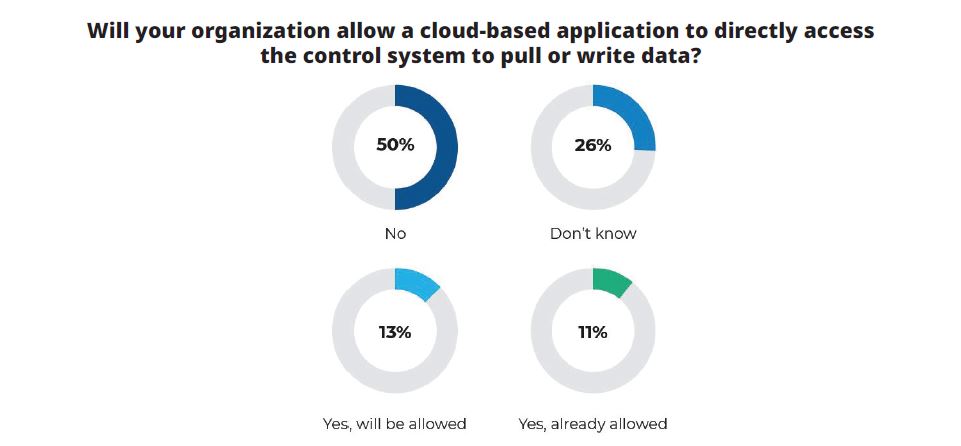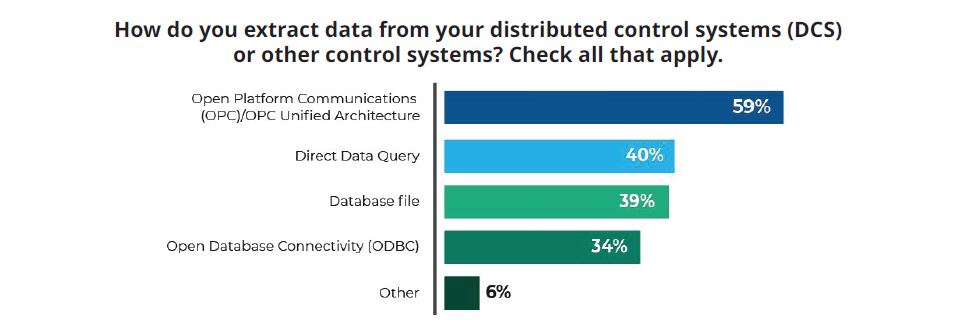
The need to gather more and more data from plant systems for analytics seems to be growing exponentially, particularly as companies expand their digital transformation initiatives to improve efficiency and sustainability across their entire operations. In fact, Emerson’s boundless automation architecture is centered on this critical need for democratized data—anytime and anywhere. Whether on the plant floor or in the boardroom, end users need data access and connectivity to provide them insights into their operations. But collecting this critical data must be easy and secure—a feat that can be accomplished, but only through effective planning.
Much of this connectivity is provided via OPC UA connections to plant systems. But, according to a recent Control Engineering study performed on behalf of Emerson, many end users are also accessing information through other methods such as direct data queries and database file connections. The reason is relatively straightforward,
“This is likely because it isn’t always possible to connect with all the desired source data using OPC. The non-OPC methods can be intrusive, putting control system operation at risk, they provide different ‘silos’ of data, and are difficult to secure.”
That final point—security—is a critical one. Study respondents ranked security as their top challenge, just above maintaining context for their data. Knowing that, it’s also unsurprising that 50% of respondents said that their companies would not allow cloud-based systems to directly access their control systems.

Fewer than 50% of process manufacturers connect their control system to the cloud.
Moving data to the cloud—the hard way
So, if OPC UA cannot get to all the data end users need, and they also cannot connect their control systems directly to the cloud, how is a team supposed to access critical data for analytics, alarms, reliability monitoring, and more? As it happens, there are two primary solutions.
First, the team can try to engineer a solution that brings the data securely to where they need it. Working closely between operational technology (OT) and information technology (IT) these cross-functional teams can use a multitude of modern technologies to draw contextualized data out of the control system and deliver it where it is needed. This strategy comes at a cost, however.
“Users are tasked with addressing networking issues such as creating a DMZ [demilitarized zone], ensuring a properly configured firewall is in place, defining ports, adhering to network policies, creating and maintaining usernames and credentials, and more. A complete solution can consume months of planning and implementation, and users are burdened with ongoing updates and maintenance.”
Even in the best-staffed plants such a process is difficult to maintain, and most of today’s plants are not staffed as well as they were even five short years ago.
—or the easy way
Alternatively, teams are finding other, easier ways to access control system data with context using solutions engineered by their automation providers. One such strategy is to stream data to a repository located at the OT edge. In such a scenario, the control system sends data to the repository using a one-way data diode, ensuring critical data is sent out to a location where it can be accessed by applications on the enterprise level or in the cloud without allowing any communication inward towards the control system.

Not all data can be easily accessed by OPC UA, so some teams must find other ways.
The advantages of such a system are numerous, but one key advantage is outlined in the study:
“This architecture provides a desirable data sandbox functionality for users to explore, test, and try on the data for customized purposes, in addition to the already-popular data cleansing and data aggregation needs.”
Your solution provider is a key ally
Few organizations have the time and resources to create complex solutions to free siloed data. By working closely with an automation provider, teams can find fit-for-purpose solutions to rescue their critical data from silos and provide it—securely—to the people who need to use it to drive efficiency, sustainability, and innovation. You can learn more about how the OT edge is reshaping how teams gain visibility to their most critical data by reading the whole eBook from Emerson and Control Engineering.




